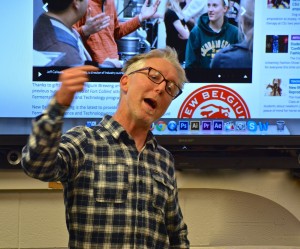Colorado State University’s journalism department has a new name that better reflects its present-day focus and breadth: Journalism and Media Communication.
Formerly called the Department of Journalism and Technical Communication, the unit continues to expand and refresh its curriculum to keep pace with dramatic changes in professional communication. These changes continue to inspire curricular innovations and additions, so the faculty decided to make the department name more inclusive.

“There are many more career options now, and we didn’t want our name to imply that we are focused in one or two specific fields,” said department head Greg Luft.
The department name change became effective July 1, after a four-year planning process prompted by enrollment trends demonstrating that technical communication had become a smaller part of what the department does, Luft said. Extensive discussion by the department’s faculty resulted in the conclusion that a new name was desirable. Subsequent surveys of high school journalism advisers and students, as well as CSU alumni and students, resulted in the faculty decision to change the name to “Journalism and Media Communication.”
“We evaluated very thoroughly what would work, and we took a good sample of opinions around the state,” Luft said, adding that the chosen name seemed most inclusive and likely to attract high school students. “We just think it connects better to key interests and doesn’t indicate a narrow approach.”
The name now also applies to undergraduate degrees, but it does not impact JMC master’s and doctoral programs in Public Communication and Technology. Those successful programs also regularly adjust curriculum to incorporate new opportunities and developments in communication related to areas such as health, risk, environment, science, technology and multiculturalism.
Continuing a specialty
While contemplating a new name and developing a fresh curriculum, the department also established an academic minor in technical and science communication. The new minor reflects a continued commitment in several of the department’s long-time programmatic specialties, and is structured so that students from other campus programs such as agriculture, sciences and engineering can include writing and communication expertise in their repertoire of skills.
The department participates in four additional academic minors, all of which have interdisciplinary components. The programs are Media Studies, Information Science and Technology, Film Studies and another new minor in Music, Stage and Sports Production. Students interested in these minors can get a taste of live television production, computer coding and information systems, film theory, and conceptual understanding of media practices and effects.
Recognizing the dramatic change and expansion of opportunities in communication technology and practices, the department several years ago eliminated its historical academic concentrations. Now, JMC offers a required core of conceptual, writing, and production courses. Students then select advanced courses that prepare them to work in any number of communication specialties. This includes preparation for the following areas of specialization in public and private media, agencies or corporate and institutional communication:

- Advertising and marketing communications
- Public relations, media relations and publicity
- Web design, management and content
- Social media, blogging and digital promotion
- Multimedia writing and scriptwriting
- Technical, scientific and health communication
- Publication reporter, writer or columnist
- Photographer, videographer and video editor
- Publication editor, designer or manager
- Electronic news reporter, producer or anchor
- Documentary or reality television writer or producer
The new curriculum includes clusters of courses and workshops to support each of these specialty areas. Recent new courses include:
- Digital promotion and management
- Social media management
- Online writing and journalism
- Business reporting
- Data journalism
- Sports reporting
- Communication-related statistics
- Web programming and development
- Mobile media
- Infographics
- Advertising creativity and copywriting
- Advertising buying and selling
- Live television production
- Audio production
- Specialized professional communication
- Advanced digital photography
- Entrepreneurial journalism
- Strategic multicultural communication
- Television studio production
- Radio operations
- University public relations
- Journalism, peace and war
- Transmedia storytelling
- Global and cultural identity
- International study abroad
Student views
With so many new options, the department was understandably careful to create a name that was inclusive. Senior Chrissi Gillispie, who chose a public relations focus, said she likes the new moniker.
“The change is great for me on a personal and professional level because the new name better reflects what I’m doing,” she said, adding that in the new curriculum she has the flexibility to take non-PR courses she’s interested in. “I can still take photography and video classes and focus my technical skills, while building on the PR and media relations side.”
“I think it’s a good change because it broadens the meaning of the major,” added student Micha Bennett, a junior who is concentrating on video to pursue a documentary film career. “I think it will be important for prospective students and incoming freshmen because it will set the tone more for what their field of study is.”
While Luft acknowledged that there are fewer traditional journalism jobs today than there were a decade ago, there is strong demand and significant growth in many fields for employees with solid communication skills. He said alumni regularly report that they get unique jobs with employers who did not previously have a communication specialist. As an example, he recently visited with one of the program’s graduates who got a media relations/communications job with a mortgage company, where he is using skills he learned at CSU, including writing, video production and website work.
“There’s a tremendous market for professional communicators today,” he said. “Most of all, students need a broad conceptual framework in the areas of professional journalism, media and communication. They also need to be nimble as writers, and have familiarity with new communication hardware and software.”
The Department of Journalism and Media Communication is in the College of Liberal Arts.